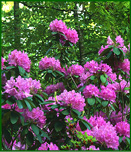Shrubs are often confused with trees and other smaller plants. However, they can be identified by their several woody stems. The plants that climb, twist, or travel along the ground or up various structures, including other trees and shrubs, are called vines. Vines are missing the strong rigid stem or trunk that can take the plant up to sunlight. They have tendrils, holdfasts, or twining stems that give them a means to climb up to sunlight. Shrubs rarely grow bigger than 15 feet and there is no real limit on the size of vines. Even with these differences, they can be confusing to sort out as some bushes like the honeysuckle also have climbing varieties. Berry bushes are technically considered shrubs but are often in a class all their own. Then there are vines that cover the ground and can form dense shrubbery-looking lumps, such as poison ivy. There are also smaller tree varieties that are included as shrubs such as sumacs.
Many shrubs flower early in spring, like the honeysuckle. Then by summer, the shrubs are already producing berries and other fruits that can last well into fall where they provide a necessary food source for various wildlife. The foliage of some of these shrubs will also change color in the fall, like sumacs, providing some of the most brilliant fall color possible for gardens, extending the season of delight.
Companion planting with these types of plants means looking at the wildlife they attract, the shade they can provide, as well as aspects like the color, size, and shape of the plant as to how well it will fit into the garden.
Akebia Vine (Akebia quinata)
The akebia is a lesser-known, fast-growing vine that is also called the chocolate vine due to its purple or white flowers that can smell like chocolate, vanilla, or spices. The plant blooms in mid-spring. It can grow to 30 and 40 feet, making it an excellent cover for arbors, trellises, and fences. The plant does need cross-pollination in order to produce fruit. It can be invasive and might need aggressive pruning to keep it contained.
The akebia is attractive to bees, butterflies, and birds that together with its unique fragrance, make it an excellent plant for the garden. It makes a good companion plant to the clematis.
Azalea (Rhododendron)
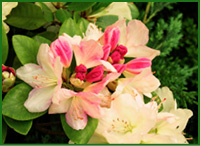
The azalea is also related to the rhododendron. This evergreen shrub prefers a well-drained soil and a sunny to partial-shade location. The plant prefers mulch and/or peat moss around its base and the roots will actually rot in soil that is too moist. The plant needs protection from strong winds. These shrubs are hardy and long lived and top the list of best garden shrubs. Azaleas, depending on variety, can grow from 2 to 6 feet high and will produce flowers in May in a wide array of colors depending on variety.
The azalea and rhododendron bushes are great for attracting birds. Hummingbirds are particularly fond of this plant. Do not plant near black walnut trees.
Bittersweet Vine (Celastrus orbiculatus)
Bittersweet is a fast-growing, climbing vine that produces yellow to orange fruits with red seeds. These make the plant a favorite for fall crafts. The vine is easy to grow and hardy. It will do well in most locations and most soil conditions. You will need to purchase both a male and a female to produce fruit as the male plant produces enough pollen for up to eight female plants, which produces the berries. The plants are difficult to tell apart until they are mature. There are two common varieties available so look for the American bittersweet as the Oriental bittersweet is considered an invasive pest. The plant can reach 60 feet and will bloom in May and June. Plant where it can climb around arbors, trellis, and fences, but preferably not other larger trees as it can grow too tight and cripple the tree.
In the fall, the plant will bring many birds and animals into the garden. It is popular with bees, birds, squirrels, rabbits, chipmunks, and toads to name just a few and will shelter many of these same animals over winter.
Bog Rosemary (Andromeda polifolia)
Bog rosemary loves being in moist soil and peat moss. It is an evergreen shrub that grows remarkably fast. It is perfect for rock gardens in full sun or partial shade. The shrub will grow from 1 to 2 feet high and could spread 3 feet wide. It produces profuse quantities of delicate white to pink flowers in May. It also offers unusual foliage in a soft blue-green color.
The bog rosemary, in the right location, will bring the pollinators into the garden in droves, making it an excellent companion plant for any flowering plants.
Butterfly Bush (Buddlei davidii)
The butterfly bush is a unique shrub to grow. The plant likes full sun but prefers a moist and well-drained soil; however, it is tolerant of most conditions. It will grow 6 to 7 feet wide and from 5 to 10 feet high. There are more than 20 different varieties, all producing flowers of different arrays of purple, blue, pink, lavender, magenta, and white. Some of the varieties have variegated leaves, dark leaves, blue-green leaves, and even silver-gray leaves, giving every gardener choice for overall effect. The flowers are produced on arching branches and can extend for 10 inches.
The plant is well named as it will attract many butterflies to your garden. It will also bring in other pollinators like bees.
Buttonbush (Cephalanthus occidentalis)
This is another easy to grow shrub that grows in most areas of the United States. This plant likes to stand in water, and needs moist to wet soil at the minimum as it will not do well in dry soils. It is perfect if you have a large water feature or a boggy area that holds moisture. It will grow 6 to 10 feet tall. In late spring to summer, the plant produces very fragrant, creamy white flowers that appear in clusters and will become brownish ball-like fruits filled with seeds in fall. Be aware the foliage is poisonous to livestock.
The plant is well loved by pollinators like bees and will attract butterflies and various wildlife. The deer will come in to eat the leaves and twigs and the buttonbush seeds are well loved by ducks and geese. Song birds are known to build nests in the shrubs and small animals will use it for shelter. It is also a good plant for shorelines as it helps to control erosion and can handle floods.
Boxwood (Buxus)
This shrub has been a popular choice for generations. It is a non-flowering evergreen that can be pruned to any desired shape. If left to grow on its own, some varieties can reach up to 20 feet. There are dwarf varieties that work great as a border, edging, or to define areas of your garden or line pathways. It has a bright green color all year long, making it a great foundation for the rest of the garden. The shrub will tolerate some drought conditions and will grow in dry soil but will do better in loamy or sandy soils. It prefers full-sun to partial-sun locations.
The boxwood, besides being a great companion plant from an ornamental perspective with the ability to be shaped as desired, is also deer resistant. The boxwood is also supposed to repel the Japanese beetle.
Clematis (Clematis)
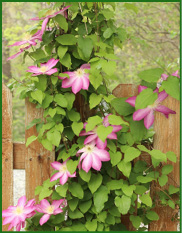
Clematis is a climbing vine that produces unique-looking flowers, depending on variety, in the spring and fall or throughout the summer. There are varieties that offer blooms of almost every color including reds, purples, pink, white, striped, and blended colors, as well as solid colors. The clematis requires a structure to climb like a trellis or tree and it likes a full-sun location in well-drained soil. Space the plants 2 feet apart.
Good companion plants for the clematis include aster, bee balm, purple coneflower, tall bearded iris, Shasta daisy, other clematis, ground covers, and climbing roses. If you choose different varieties of clematis and plant them together, you will have a showy display all growing season. They also attract hummingbirds.
Cotoneaster (Cotoneaster)
Cotoneaster is a perfect ground cover shrub that has glossy green leaves all summer and then turns to a beautiful red in fall. There are red berries throughout summer and fall. The plant likes full sun but will tolerate partial shade. It also does better in well-drained soils. The type of plant makes it ideal for rock gardens, covering large ugly spaces. The cranberry cotoneaster will grow to only 3 feet tall with pink flowers it the spring. At the other end of the scale is the bearberry cotoneaster, which can reach 14 to 18 feet high, producing white flowers in spring.
It is a great plant for stabilizing unstable hillsides and for erosion control. It is well known for attracting pollinators like birds.
Devil’s Walking Stick (Aralia spinosa)
Devil’s walking stick is also known as Hercules’ club. This deciduous shrub offers a moderate growth rate, dense foliage, and both flowers and fruit. Hardy throughout most of North America, the shrub can reach from 10 to 20 feet in height. There are many thorns on the branches so be careful when working around it. The new foliage comes in bronze and changes to yellow and red-orange in the fall. The plant flowers in summer with clusters of small white flowers and then produces clusters of purple black berries. The plant will tolerate a wide range of growing conditions but prefers sun to partial shade and a well-drained location.
The Devil’s walking stick is a good companion to plants you want to protect from small animals due to its heavy thorns. The flowers attract bees and tiger swallowtail butterflies, and the fruit attracts many different birds.
Deutzia (Deutzia)
Deutzia will grow in both moist or dry conditions but prefers a well-drained soil in a full-sun to partial-shade location. The plant is great for a hedge and will flower starting in May. There are many great varieties and the Chardonnay Pearls Deutzia is one of the most fragrant. It has lime-yellow foliage and produces pearl-like buds that open to star-shaped flowers in springtime. Like most of the deutzia varieties, it is a compact bush that will grow 2 to 3 feet high and should be spaced at least 2 feet apart. The shrubs like a full-sun location in well-drained soil.
Most of the deutzia shrubs are deer resistant. The fragrant flowers will attract butterflies and pollinators to your garden.
Dutchman’s Pipe Vine (Aristolochia durior)
This vine is a bold statement for any garden with its large, 6- to 10-inch, heart-shaped leaves and height of 30 feet. The plant likes a full-sun to light-shade location with well-drained soil and some structure to climb as it will twine around the nearest object. It will grow rapidly once established. It is grown mostly for the unique foliage but it will produce mahogany- and cream-colored flowers in late spring. The flowers have a unique fragrance as well.
The plant is a good companion for plants requiring dense shade. The flowers will attract birds and butterflies, in particular the swallowtail butterfly.
Fothergilla (Fothergilla major)
Fothergilla is often called bottlebrush (Callistemon) but these two plants are quite different. Fothergilla is a nice addition to a garden. The shrub grows approximately 3 feet high and needs to be spaced 3 to 4 feet apart. The plant likes a full-sun to partial-shade location in a moist but well-drained soil. It will produce spring flowers, usually white, sticking out straight from a center stem like a bottle brush. There are several varieties available, including Blue Shadow that has silvery blue foliage turning to yellows, oranges, and reds by fall.
The bottlebrush, as it prefers a slightly acidic soil, makes a good companion to the rhododendrons and azalea bushes. It will also attract birds.
Glossy Abelia (Abelia x grandiflora)
Abelia is a beautiful, hardy shrub that provides profuse blooms with intense fragrance. It is a great alternative to the lilac bush. It grows from 6 to 9 feet high and should be spaced 10 feet apart. This shrub does better with a full-sun to a partial-shade location. The blooms arrive in late spring in a soft pink or white if you choose Abelia chinensis. An additional attraction of the A. x grandiflora shrub is that the glossy green foliage turns orange-red in fall. The plant can be pruned and shaped easily. It will grow in a wide variety of soil conditions and is happy without much care. The Abelia mosanensis is a lovely fragrant variety.
Abelia is deer resistant and is one of the best for attracting birds while offering seasonal interest throughout the year.
Japanese Barberry (Berberis thunbergii)
Japanese barberry, also known as Thunberg’s barberry and red barberry, is an excellent flowering shrub for your garden. It will tolerate drought and can grow well in drier soil. It needs a well-drained, loamy soil in a full-sun to partial-shade location. The purple variety will turn green in the shade. It prefers a more acidic location that has a pH level of 7.7. It is considered allergy free and pest tolerant. The bush can grow, depending on the variety you choose, from 3 to 9 feet high. They generally produce yellow flowers on very thorny stems. Some, like the Japanese barberry, will turn a reddish-purple in the fall.
Barberry is a good companion plant for the garden as it will attract pollinators like birds. The thorns also make it a good barrier plant.
Honeysuckle (Lonicera)
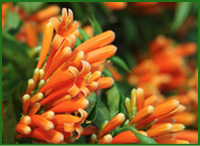
Honeysuckle is a popular plant found in many gardens across North America with the Japanese honeysuckle (Lonicera Japonica) being one of the most common. The plant grows quickly and comes as a shrub or a vine that can grow up tree trunks or other shrubs so plant close to trellises or fences for support. It is most often grown for its sweet-smelling flowers that are followed by small black berries. The plant blooms from April through to July. The flowers come in white and in shades of red, orange, and yellow. Plant in a full-sun location where it will have a chance to fulfill its 25 feet of growth.
The honeysuckle is a great companion plant for any garden as its fragrance will attract butterflies, pollinators, and birds, especially hummingbirds. Insects drink the nectar and the birds eat the berries, plus deer have been known to eat the plants. Small animals may use the plant as shelter.
Hydrangea (Hydrangea)
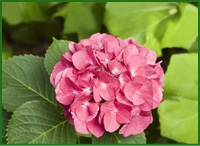
Hydrangeas are easy-growing, flowering shrubs. They will grow from 6 to 8 feet high and need to be spaced at least 6 feet apart. Some varieties prefer shade and there are a few that like sunny spots, so it is important to pick the right variety for the garden location. The flower colors vary widely from white to blue to burgundy, pinks, and purples. There are shrub, tree, and climbing varieties like the Hydrangea petiolaris that can go to 50 feet. Some of the plants are highly prized for their foliage, like the oakleaf hydrangea (Hydrangea quercifolia), which produces wine, orange, and deep mahogany colors in the fall.
With the oakleaf hydrangea in particular, song and game birds, as well as mammals, eat the seeds. The flowering hydrangea is a good shade plant to bring in pollinators and fill shady corners. The tropical hydrangea produces fragrant red and pink blooms. The bush attracts bees and butterflies.
Ivy (Hedera)
English ivy (Hedera helix) plants are evergreen vines. They can grow horizontal along the ground or climb up fences, rocks, and any other structures like trees. The plants do well in partial-shade to full-sun locations in well-drained soil. They can bear greenish flowers but are grown for their foliage. They are considered an invasive plant by many but they are a good choice for shady areas like under trees. Another favorite to consider is Boston ivy (Parthenocissus tricupspidata).
Ivy is a great groundcover, covering large unsightly areas and choking out weeds. It can also be used for erosion control or to cover large walls, unsightly sheds, fences, and more. Ivy is known to attract tachinid flies and birds. Boston ivy is known to attract bees.
Lilac (Syringa vulgaris)
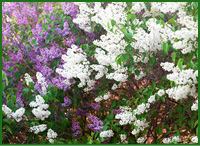
Lilacs are an old-fashioned shrub that never goes out of style. The shrubs are low maintenance and will grow in a variety of locations and soil conditions. They can be planted on their own or together to form a hedge. They do like well-drained soil so plant where they will not sit in water. They will benefit from mulch but because new shoots will come up, keep the mulch only a few inches thick. Lilacs bloom for only few weeks at time so it helps to have both early and later flowering varieties planted together for continuous blooms. The colors of blooms vary slightly but most common are white, lavender, blue, pink, and purple. Flowers come in both single and double petal varieties as well. Some lilacs can grow as high as 30 feet and there are dwarf varieties barely reaching 3 feet. As there are more than 1,000 varieties, there is sure to be a variety for every garden.
Lilacs are a good companion to many garden flowers and vegetables. They can function as a windbreak for those plants needing shelter and shade for plants that do not like too much sun. Lilacs do not do well close to black walnut trees.
Porcelain Berry Vine (Ampelopsis brevipedunculata)
This vine is easy to grow, flowers quickly, and sets fruits easily. The plant needs a full-sun location but will grow in a variety of soil conditions, provided it is well-drained. Mulch around the base helps to prevent the weeds from taking over until the plant is well established. The vine will need structural support, making it another good plant for trellises or covering up old fences. Cut it back in the fall to keep it under control. There are dark green leaf and variegated leaf varieties. It is fast growing and is considered invasive by some. If you plant it, cut it to the ground in late winter to avoid it taking over. It can reach 20 feet in length. After flowering, it will produce clusters of green, purple, and blue fruits.
The plant is known to attract bees and butterflies. The profusion of fruit at the end of the season brings in many different types of birds.
Rhododendron (Rhododendron)
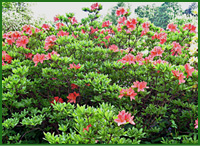
Rhododendrons are a common sight across the country. With their big bright flowers they make a great addition to any garden. They love an acidic soil and will grow best in partial-shade. They prefer a peat moss base and must have a well-drained location. There are many varieties available today offering different colored blooms including pinks, reds, whites, lavenders, and purples. They do not like windy locations.
Rhododendrons, particularly the Carolina and purple varieties, are known to attract birds, especially hummingbirds. Good companions for the rhododendron are astilbe, pieris, and viburnum. Do not plant close to a black walnut tree.
Roses (Rosa)
Roses are a traditional and well-loved plant. Roses can be bushes, trees, or climbers. There are many kinds of roses with a wide variety of blooms available, covering most shades of colors. Rose colors hold a special meaning, such as red for love, pink for appreciation, and yellow roses symbolize joy and friendship. Regardless of the type of rose, they all like similar growing conditions. Roses like a well-drained soil with a neutral pH and will also tolerate a slightly alkaline soil. They like a full-sun location.
There have been complete books written on roses and one common companion planting theme is that they grow well with garlic because the rose’s roots pick up the exudations from the garlic, making the plant less attractive to some insects like green flies and aphids. But there are also many other plants that make great companions to roses, like parsley that works to keep green flies away. Marigolds and tansy are also effective as pest repellants. Nasturtiums make a great trap crop by attracting the insects to it and therefore away from the roses. Chives and other members of the allium family are said to increase the perfume of the roses, ward off aphids, and help to prevent black spots. Herbs are also great companions, such as thyme, which are said to ward off Japanese beetles and aphids. Lavender and catmint are helpful for keeping rabbits away. Four o’ clocks and larkspur are said to kill Japanese beetles. Planting yarrow will help attract in ladybugs, which in turn feast on aphids.
Rose-of-Sharon (Hibiscus syriacus)
This flowering shrub can grow up to 10 feet tall and spread at least half that height. There are a few varieties that are shorter. Some varieties produce single flowers and others offer double flowers, meaning flowers that have extra petals or flowers within flowers. The shrubs will bloom in later summer long past when most other flowering shrubs have finished their blooming cycle. There is a wide range of flower colors including white, red, blue, and lavender. This member of the hibiscus family loves heat and is even drought tolerant once established. Plant in a full-sun location in well-drained soil.
Rose-of-Sharon is known to attract hummingbirds. It will also attract other birds and butterflies.
Santolina (Santolina)
This plant is also known as cotton lavender, gray lavender, lavender cotton and gray santolina, petite cypress, holy herb, and ground cypress. There are several dozen varieties of santolina and it belongs to the aster family. This small evergreen shrub grows to approximately 1½ to 2 feet tall. The plants need to be spaced about 1 foot apart. It is generally grown for its aromatic silver-gray evergreen foliage. It does produce clusters of bright yellow, ball-like flowers in mid- to late spring. It makes a great border or edging plant. Once the flowering is done, prune the plant back to promote bushiness.
Santolina is a good companion for roses and can be used as a groundcover to keep weeds down. Rabbits do not like santolina and the plant is known to deter some insects like moths. As a dried plant, it is mixed with lavender for a mothball replacement in drawers and closets.
Scotch Broom (Cytisus scoparius)
This deciduous shrub is also known as Scottish broom, English Broom, and common Broom. The shrub can reach as high as 10 feet and will expand to close to 6 feet wide. It is an upright, rounded shrub that likes a sunny location and prefers dry soil conditions in poor soil. It will flower in late spring on old growth. The flowers vary depending on type and can include red, pink, and gold flowers. The foliage is bright to medium green and stays this color over winter.
The plant is known to attract birds of all kinds.
Silver Lace Vine (Polygonum aubertii)
The silver lace vine is a vigorous climber that will easily cover 25 feet in one growing season. If your winters are harsh, the plant will die back and may only grow 15 to 20 feet the following year. In summer, the vine produces tiny fragrant white blooms that cover most of the plant and stay throughout the bulk of the growing season. The vine does well in most locations except total shade. The plant is also tolerant of most soil conditions but prefers well-drained soil. Once established, it is drought tolerant. They have a strong root system that will take over the space around them so plant them 4 feet from other plants. Choose a location with firm support before planting.
The silver lace vine, besides providing fast coverage of old fences and ugly corners in a garden, works well to provide shade for the garden. It also attracts hoverflies.
Spice Bush (Lindera benzoin)
The spice bush is a small shrub that grows approximately 6 feet tall. It grows wild across much of the United States and is often mistaken for witch hazel. The leaves start off dark green but turn yellow in the fall. The leaves give off a pleasant aroma when they are crushed. This shrub is one of the first to flower in the spring and it produces small yellow blooms in March and April. After flowering, small red berries are produced. The plant grows in most locations and most soil conditions, making it an easy option for the back corners of a yard where nothing else grows well.
The fruit of the spice bush attracts various birds like robins, Eastern Kingbirds, and Northern Bobwhite. The spicebush is ideal for a butterfly garden as it attracts many of them, in particular the Spicebush Swallowtail and the Eastern Tiger Swallowtail. It is also known for attracting wildlife as deer like to eat the leaves and twigs. It also makes a good shelter for small mammals. The spice bush is a good companion plant for elderberry.
Strawberry Bush (Euonymus americanus)
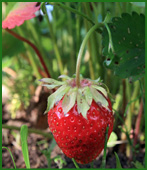
This shrub is also known as Bursting-heart, Hearts a’Bustin, and Brook Euonymus. The strawberry plant will grow from 4 to 6 feet tall and will need to be spaced a couple of feet apart from each other. They like a light-shade to a full-shade location in well-drained soil. It is drought tolerant once established and its evergreen foliage is a blue-green. It is a fairly innocuous looking plant but grows nicely in difficult locations where many other plants will not. The bush flowers in mid-spring through early summer when it produces pale yellow to yellow-green flowers. However, it is in the fall when the plant really shows well as it becomes covered in a globular fruit starting in August and the fruit ripens until it turns the color of fuchsia raspberries. In fall, the husk opens to show five stunning bright red berries hanging by a fine stem.
The strawberry is a big attraction for the various birds including wood thrushes, Eastern bluebirds, Yellow-rumped Warblers, and Northern Mockingbirds. The leaves and twigs are poisonous for cows so do not plant close to livestock.
Sumac (Rhus)
There are many sumac varieties, with some like the smooth sumac (Rhus glabra) growing 10 feet high and the winged sumac (Rhus copallinum) reaching upwards of 30 feet. The sumac generally does not live more than a few years, and it is common in open woods and fields. It prefers dry soil and makes a great thicket when grown close together. There are poisonous varieties that can cause a skin rash, but there are non-poisonous sumac varieties that offer a stunning autumn display of color. The poisonous varieties have hanging white berries and the non-poisonous have red berries that grow upright.
Besides bringing in stunning autumn color, the sumac is well noted for its ability to attract birds of all kinds, including Mourning Dove, Eastern Bluebird, Northern Cardinal, Brown Thrasher, Dark-eyed Junco, and Purple Finch. Rabbits will eat the bark and white-tailed deer will eat the leaves and stems if available. The shrub can also offer shelter for many small animals.
Sweet Pepper Bush (Clethra alnifolia)
This deciduous shrub is also known as Anne Bidwell and summersweet. There is another common variety called the mountain pepper bush or cinnamon bark clethra (Clethra accuminata). These bushes can grow up to 12 feet tall. They like a sunny to partial-shade location and like a moist soil. The mountain pepper bush prefers a well-drained soil whereas the sweet pepperbush will tolerate flooding and wet soils. The shrubs will flower in early summer when it produces long stalks of white flowers. Some varieties produce pink flowers. The flowers are also fragrant. The mountain pepper bush also has a red cinnamon-colored bark.
The shrub is a good plant for any garden or lawn. It is known to attract bees, butterflies, and hummingbirds. The seeds produced after flowering bring in the birds again.
Trumpet Vine (Campsis radicans)
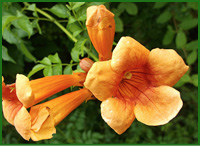
The trumpet vine is also known as the trumpet creeper, hummingbird vine, and Cow Itch. This woody vine can reach 30 feet in height with the main stem going 7 inches thick. The vine is well-known for producing stunning bright red flowers that are approximately 3 inches long. The vine can grow up trellises, fences, and walls but if there is nothing around to climb, it will stay as a small shrub but this is rare. The vine blooms from early summer through to September. The trumpet vine is often mistaken for a close relative called the cross vine. The cross vines are slightly shorter with smaller flowers. The trumpet vine prefers a full-sun location but will tolerate partial-shade. They require regular watering during the growing season. The vines will also reseed easily so care needs to be taken that the vine does not take over as it can become invasive. Some people can get a rash similar to poison ivy from the vine.
The trumpet vine is one of the most important nectar sources for the ruby-throated hummingbird. There are very few critters that can reach the nectar inside the long flowers and hummingbirds and bumblebees are two of them. They are required to pollinate the flowers. Many animals use the trumpet vine as a shelter as well, including the American Goldfinch, the Great Crested Flycatcher, and the Common Yellowthroat.
Viburnum (Viburnum)
Viburnum flowering shrubs have been a popular choice for gardeners for years. With more than 150 varieties to choose from, there is a perfect choice available for everyone. Some grow well in sun, others in shade; some grow as shrubs, others as trees. There are varieties that like wet soil and some that prefer dry. Most viburnum varieties are happy in the sun and will adjust to partial-shade. As a general rule, they like alkaline to neutral soils but check with your local nursery center. These shrubs actually belong to the honeysuckle family and most are hardy and pest resistant. Viburnums are great as a single bush or when planted together as a hedge. They do flower in white or pink with blooms that resemble snowball flower. There are a couple of self-pollinating varieties but most will need another variety to produce fruit.
Viburnums are a great choice if you are looking to increase the bird presence in your garden. Birds and small animals alike enjoy the small fruits. Viburnum is one of the best shrubs for attracting butterflies.
Virginia Creeper (Parthenocissus quinquefolia)
This fast-growing vine is a common sight in gardens as a groundcover. It can quickly grow out of control and needs to be pruned regularly. It does grow well in shade, making it valuable to cover dirt under trees and in dark corners. It can grow up to 50 feet in length and will grow sideways or climb. It will grow in most locations and soil conditions. The leaves are green with a red blush and in the fall, the leaves become a deep red. The vine produce greenish-yellow clusters in June through to the end of summer. The fruits are tiny black berries.
The berries of the Virginia creeper bring in the birds, including the Eastern Bluebird, Northern Cardinal, chickadees, and woodpeckers. The vine also attracts other mammals such as mice, chipmunks, squirrels, and deer.
Virginia Rose (Rosa virginiana)
The Virginia rose is also known as common wild rose or prairie rose. It is a woody shrub that is part of the rose family and is considered an invasive weed in much of North America. It can grow up to 6 feet in height and will produce pink flowers in summer and can grow just about anywhere. Be prepared to keep its growth regulated or it will take over your garden.
The Virginia rose is an excellent choice for your garden if you want to encourage wildlife because it is an important food source for many critters. It attracts pollinators like bumble bees and honey bees. It is the fleshy bulb or rose hip that is left behind once the flower dies that makes the plant so valuable. These hips are large and will stay on the plant throughout the fall and winter. They are a food source for many birds including American Robin, Northern Mockingbird, Cedar Waxwing, Eastern Bluebird, American Goldfinch, Northern Cardinal, and even the Song Sparrow. Skunks and mice eat them as well. The leaves also attract butterflies including Mourning Cloak and Red-spotted Purple butterflies. The heavy brush provides shelter for other animals and birds as well.
Weigela (Weigela)
Weigela is another old-fashioned favorite. It is easy to grow, requires little maintenance, and flowers in a variety of colors. The shrub prefers a full-sun location and will adapt to most soil conditions. Some of the weigela varieties will grow up to 8 feet high and 8 feet wide so read the label on the plant before choosing the best location. The shrub appreciates a layer of mulch around the base once planted. In late spring through summer, the weigela produces trumpet-like flowers in pink, red, white, and purple. There are variegated and purplish foliage varieties available.
Weigela flowers are known as a favorite nectar source for hummingbirds, and in the fall, the birds come for the seeds.
Wisteria (Wisteria)
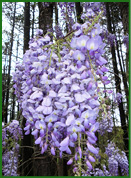
This hardy vine offers thousands of clusters of pendulum-shaped flowers. The Chinese and Japanese varieties will bloom in white, pink, lilac, and purple and are slightly frost hardy. They are both strong growers and are often considered invasive so be prepared to prune the vines to keep them in control. The American variety is less aggressive and less frost hardy, but it blooms lavender and mauve once in spring and again in September. Purchase the largest plant you can afford as the larger the plant, the sooner it will flower. Wisteria can be grown from seed – if you have a dozen years to wait for it to bloom. Wisteria does best in a full-sun location but can tolerate some shade in a neutral to slightly acidic soil (6 to 7 pH). The plant will need a strong structure to climb and it will become very heavy as it gets older so consider planting wisteria close to pergolas and wooden arbors.
Wisteria is a scented shrub that attracts insects as well as the predators that consume them. Two main birds that love the wisteria are flycatchers and warblers. The dense foliage offers cover for nesting birds. Wisteria also attracts pollinators like bees as well as butterflies.
Witch Hazel (Hamamelis)
Witch hazel is unique in that it flowers in winter, making it one of the few flowering shrubs offering winter color. The common witch hazel blooms in late fall and the variety called Vernal witch hazel blooms in early spring. They usually grows to 15 feet but can mature up to 30 feet long. It grows wild in many forests but has become popular as a landscape plant. Depending on the species, the small, party streamer-looking flowers bloom in yellow, gold, orange, and red with the H. japonica variety offering a purple tone. Most of the varieties offer a nice spicy scent. The foliage also turns from dark green to yellow with a blush of red and purple come fall. The shrub prefers shade but will adapt to some sun. They are tolerant of most soil conditions but do prefer a moist, well-drained soil.
As it is a shade-loving plant, witch hazel does well growing underneath large trees and is often found under hickories, American elm, poplar, pine, and red maple trees. The bush provides shelter for birds and small animals and the seeds are food for chipmunks, squirrels, rabbits, as well as attracts in many birds.
Yucca (Yucca)
Yucca plants are hardy throughout most of the United States. They will grow close to 10 feet in height. They have woody stems and beautiful spiky, sword-shaped leaves. They are available with variegated or solid colored leaves including red to pink shades. Yuccas are available in many variety of shapes and sizes with the differences being in the length of the stem and their flowering ability. Plant in full-sun in well-drained soil. They should be no closer than 1½ feet apart for small varieties and 4 feet apart for larger varieties. Their sword-shaped leaves are sharp. The plants do well even when virtually ignored. They will bloom, shooting up a stalk of huge white, bell-like flowers in the summer
The yucca is great as a centerpiece in a garden or a border. The flower stalk with its 4-inch white flowers tinged in red or purple attracts hummingbirds.
